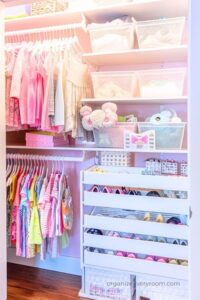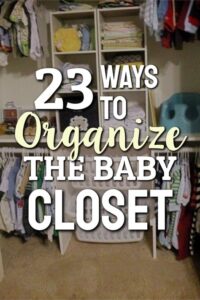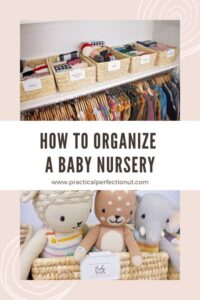Uncategorized
How to Organize and Maximize Your Kids’ Closet
Organizing and maximizing your kids’ closet can often feel like a daunting task, especially when it seems like there’s never enough space for everything. From their ever-growing collection of clothes to the shoes, accessories, and toys, it’s easy for closets to become cluttered. However, with a little planning and smart strategies, you can create a system that not only makes it easier to find what you need but also ensures that the closet stays tidy and functional. In this guide, we’ll walk you through practical tips and creative solutions to help you organize and maximize your kids’ closet, making it both efficient and accessible.
1. Declutter First: Start with a Clean Slate
Before diving into any organizing methods, take the time to declutter. Go through your child’s closet and pull out items that no longer fit, are worn out, or that they haven’t worn in a while. Set aside outgrown clothes to donate, sell, or store for future siblings. A decluttered space makes it easier to organize and keep everything in its place.
Tips for Decluttering:
- Sort clothes by size, and separate them into “keep,” “donate,” and “store” piles.
- If you’re unsure about a piece, ask your child if they still like it or wear it.
- Don’t forget to check for seasonal items and remove clothes that are out of season.
2. Sort Clothes by Category
Once you’ve decluttered, sorting clothes by category is essential for creating a functional closet system. Group items into categories such as shirts, pants, dresses, jackets, and pajamas. This will make it easier to find what you need and help your child learn to put things away in the right place.
Category Ideas:
- Everyday clothes (T-shirts, jeans, leggings)
- Dressy clothes (formal outfits, dresses, suits)
- Outerwear (coats, jackets, rain gear)
- Shoes (sneakers, sandals, boots)
- Accessories (hats, scarves, belts)
Tip: Label shelves, bins, or baskets for each category so that everything has a designated spot, making it easier to organize and maintain.
3. Maximize Closet Space with Smart Storage Solutions

Kids’ closets are often smaller than adult closets, so using the available space wisely is key. There are many storage solutions available that can help you make the most of the vertical and horizontal space in the closet.
Storage Ideas:
- Double Up on Hanging Rods: Install a second hanging rod below the first one to store shorter items like shirts, skirts, or pants. This creates extra space for longer pieces below.
- Add Shelves or Bins: Use adjustable shelves or stackable bins to store shoes, hats, and toys. This not only keeps everything organized but also helps utilize space that would otherwise be wasted.
- Hanging Organizers: Use hanging organizers for small items like scarves, shoes, or accessories. These are easy to install and offer additional storage without taking up valuable floor space.
- Over-the-Door Storage: Hang hooks or pockets over the door to store bags, hats, or other accessories that don’t need to take up shelf space.
Tip: Invest in clear bins or storage containers so you can easily see the contents. Labeling the bins adds an extra layer of organization and helps your child learn where to find and store things.
4. Use Adjustable Hangers
Using adjustable hangers for kids’ clothes is a simple yet effective way to save space. These hangers can be customized to fit different sizes and types of clothing. They keep items from slipping off and help you create a more uniform look inside the closet.
Tip: Use slim, non-slip hangers to maximize closet space, as they take up less room than traditional plastic hangers. Consider using velvet-covered hangers for items like dresses or delicate clothing.
5. Incorporate Seasonal Rotations
One of the most effective ways to maximize closet space is by rotating clothes seasonally. Store out-of-season clothes in bins or under the bed, leaving only the current season’s items in the closet. When the seasons change, simply swap the clothes to keep things organized and prevent overcrowding.
Tip: Label your seasonal bins with both the season and the size of the clothes. This will make it easier to grab and go when the time comes.
6. Create a “Kid-Friendly” System

Make sure your organizing system is kid-friendly, meaning that your child can easily access their clothing and put things away themselves. Consider your child’s age and abilities when setting up their closet. For younger children, use lower rods and shelves so they can reach their clothes easily. As they grow, you can move things higher to encourage independence and responsibility.
Kid-Friendly Closet Tips:
- Hang clothes at an age-appropriate level so your child can easily access them.
- Use bins or baskets with labels or pictures for younger children to easily identify their clothes.
- Create a “get dressed” station with outfits already coordinated so your child can choose their clothes without overwhelming them with options.
7. Keep Shoes Organized
Shoes can be one of the most challenging items to keep organized, especially as kids grow quickly and outgrow shoes often. Use shoe racks, cubbies, or clear bins to organize footwear by type or size.
Shoe Organization Ideas:
- Shoe Rack: Install a shoe rack inside the closet or at the entryway to keep shoes neat and easily accessible.
- Clear Bins: Store shoes in clear plastic bins with labels to help you locate the right pair quickly.
- Over-the-Door Shoe Organizers: Utilize space on the back of the closet door for additional shoe storage.
Tip: Organize shoes by season (boots in winter, sandals in summer) to keep things easy to find.
8. Incorporate Labels for Easy Maintenance
Labeling your kid’s closet isn’t just helpful for you—it’s also a great way to encourage your child to put things back where they belong. Use clear and easy-to-read labels for each section of the closet, such as “Pants,” “Shirts,” “Hats,” or “Shoes.”
Labeling Ideas:
- Use color-coded labels for different types of clothing.
- Add pictures to the labels if your child is too young to read.
- Label baskets or bins for accessories and toys.
Tip: Label both the inside of the closet and the storage containers to help your child stay organized and know where things go.
9. Regularly Maintain the Closet
A well-organized closet is a system that needs regular maintenance. Set aside time each month to reassess and reorganize the closet. This will help ensure that outgrown clothes, seasonal changes, and clutter are addressed before they take over.
Maintenance Tips:
- Review and donate clothes your child has outgrown.
- Swap out seasonal items to keep the closet fresh and functional.
- Encourage your child to help tidy up their closet to maintain the system.
10. Make It Fun!

Finally, organizing your kids’ closet doesn’t have to be a chore. Involve your child in the process and make it fun. Let them pick out storage bins or hang up their clothes in a way that appeals to them. A closet should reflect their personality and interests, so be sure to include some fun touches, such as colorful bins or a display area for favorite items.
Tip: Use storage options that are playful and colorful to make the closet inviting for your child.
Conclusion: A Tidy Closet, A Happy Home
Organizing and maximizing your kids’ closet doesn’t have to be a stressful task. By following these tips and strategies, you can create a system that works for both you and your child. An organized closet helps save time, reduces stress, and encourages your child to take responsibility for their belongings. Plus, it can make mornings a lot smoother when everything is easy to find and accessible. Start today and turn your kids’ closet into a space that’s both functional and fun!


